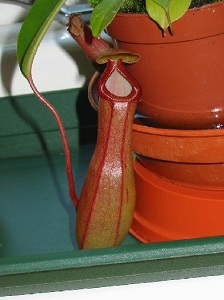
Botany
Tropical Pitcher Plants
Nepenthes
Nepenthes are the most elegant pitcher plants and also have the most elaborate of any traps. These are the pitcher plants of South Asia. There are over 160 species of these amazing plants and of these the most can be found on one mountain in Borneo.
As the name "Pitcher" suggests nepenthes, has a jug like trap, with a "lid" which hangs over it, protecting it from rain and attracting insects. Surrounding the mouth there is a lip or peristome, which also acts to attract the prey. Inside the trap there is a waxy surface so the insect prey falls to its death below.
The trap starts as a stem or tendril, which grows from the tip of the proper leaf. This gains support either on the ground or by twisting around the stem of another plant and then starts to swell and inflate. After it finishes inflating it opens into the trap.
The traps are filled with a liquid that contains enzymes and acids, which together digest their prey. This is so strong that a fly can be digested in just days.
Strangely some animals do manage to survive in these traps, many different species of insect larvae feed of the dead and decaying matter, which accumulates at the bottom. They are then, in turn eaten by larger animals including the Red Spider Crab, Ants and the largest of all a crab. Each species of nepenthes has its own specific occupants.
Specialisation is common with one species, N albomarginata, surviving on a diet of termites. Another group of species feed on tree shrew dropping, the strangest of which is N. lowii with its odd misshapen upper pitchers, which acts as a seat and where a lid acts as a lick for the shrews. Oddly N. rajah, which is the largest species, also feeds on tree shrew droppings despite having reportedly caught rats in the past. A different species has been found to host roosting bats and feeds from their droppings.
